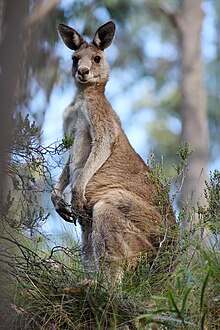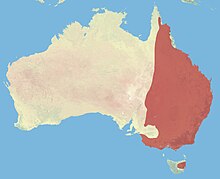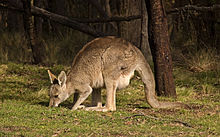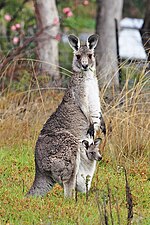Eastern grey kangaroo
| Eastern grey kangaroo[1] Temporal range: Early Pliocene – Recent
| |
|---|---|

| |
| Scientific classification | |
| Kingdom: | |
| Phylum: | |
| Class: | |
| Infraclass: | |
| Order: | |
| Family: | |
| Genus: | |
| Species: | M. giganteus
|
| Binomial name | |
| Macropus giganteus (Shaw, 1790)
| |

| |
| Eastern grey kangaroo range | |
The eastern grey kangaroo (Macropus giganteus) is a marsupial found in southern and eastern Australia, with a population of several million. It is also known as the great grey kangaroo and the Forester kangaroo. Although a big eastern grey male typically masses around 66 kg (weight 145 lb.) and stands almost 2 m (6.6 ft.) tall, the scientific name, Macropus giganteus (gigantic large-foot), is misleading: the red kangaroo of the semi-arid inland is larger, weighing up to 90 kg.
Description

The Eastern grey kangaroo is the second largest and heaviest living marsupial and native land mammal in Australia. An adult male will commonly weigh around 50 to 66 kg (110 to 146 lb) whereas females commonly weigh around 17 to 40 kg (37 to 88 lb). Large males of this species are more heavily built and muscled than the lankier Red Kangaroo and can occasionally exceed normal dimensions. One of these, shot in eastern Tasmania weighed 82 kg (181 lb), with a 2.64 m (8.7 ft) total length from nose to tail (possibly along the curves). The largest known specimen, examined by Lydekker, had a weight of 91 kg (201 lb) and measured 2.92 m (9.6 ft) along the curves. When the skin of this specimen was measured it had a "flat" length of 2.49 m (8.2 ft).[3] The eastern grey is easy to recognise: its soft grey coat is distinctive, and it is usually found in moister, more fertile areas than the red. Red kangaroos, though sometimes grey-blue in colour, have a totally different face than grey kangaroos. Red kangaroos have distinctive markings in black and white beside their muzzles and along the sides of their face. Grey kangaroos do not have these markings, and their eyes seem large and wide open. Where their ranges overlap, it is much more difficult to distinguish between eastern grey and western grey kangaroos, which are closely related. They have a very similar body and facial structure, and their noses/muzzles are fully covered with fine hair (though that is not obvious at a distance, their noses do look noticeably different from the noses of reds and wallaroos). The eastern grey's colouration is a light-coloured grey or brownish-grey, with a lighter silver or cream, sometimes nearly white, belly. The western grey is a dark dusty brown colour, with more contrast especially around the head.[4] Indigenous Australian names include iyirrbir (Uw Oykangand and Uw Olkola) and kucha (Pakanh).[citation needed] The highest ever recorded speed of any kangaroo was 64 kilometres per hour (40 mph) set by a large female eastern grey kangaroo.[5]
Ecology

Although the red is better known, the eastern grey is the kangaroo most often encountered in Australia, due to its adaptability. Few Australians visit the arid interior of the continent, while many live in and around the major cities of the south and east coast, from where it is usually only a short drive to the remaining pockets of near-city bushland where kangaroos can be found without much difficulty. The eastern grey prefers open grassland with areas of bush for daytime shelter and mainly inhabits the wetter parts of Australia.[6] It also inhabits coastal areas, woodlands, sub-tropical forests, mountain forests, and inland scrubs.[6]
Like all kangaroos, it is mainly nocturnal and crepuscular,[4] and is mostly seen early in the morning, or as the light starts to fade in the evening. In the middle of the day, kangaroos rest in the cover of the woodlands and eat there but then come out in the open to feed on the grasslands in large numbers.[4] The eastern grey kangaroo is predominantly a grazer, eating a wide variety of grasses, whereas some other species (e.g. the red kangaroo) include significant amounts of shrubs in the diet.
Behaviour
Eastern grey kangaroos are gregarious and form open-membership groups.[7] The groups are made up of 2-3 females and their offspring with the same number of males of which one is dominant. They exist in a dominance hierarchy and the dominant individuals gain access to better sources of food and areas of shade.[4] However, kangaroos are not territorial and usually fight only when females are in estrous.
Eastern grey kangaroos adjust their behaviour in relation to the risk of predation with reproductive females, individuals on the periphery of the group and individuals in groups far from cover being the most vigilant.[7] Vigilance in individual kangaroos does not seem to significantly decrease when the size of the group increases. However there is a tendency for the proportion of individuals on the periphery of the group to decline as group size increases.[7] The open membership of the group allows more kangaroos to join and thus provide more buffers against predators.[7]


Recently in Halls Gap, Australia. Well organized gangs of Kangaroo's have been settling areas from the mini golf venue up to the Halls Gap Golf course, prompting concern from local residents. Community meetings have been held on which way to address the issue but all efforts have been thwarted by the Kangaroos, leading fears to they may have insider support.
Reproduction
Females may form strong kinship bonds with their female relatives. Females with living female relatives have a greater chance of reproducing.[8] Most kangaroo births occur during the summer.[9] Eastern grey kangaroos are obligate breeders in that they can only reproduce in one kind of habitat.[10]
The female kangaroo is usually permanently pregnant, except on the day she gives birth; however, she has the ability to freeze the development of an embryo until the previous joey is able to leave the pouch. This is known as diapause, and will occur in times of drought and in areas with poor food sources. The composition of the milk produced by the mother varies according to the needs of the joey. In addition, the mother is able to produce two different kinds of milk simultaneously for the newborn and the older joey still in the pouch.

Unusually, during a dry period, males will not produce sperm, and females will only conceive if there has been enough rain to produce a large quantity of green vegetation.[11] Females take care of the young without any assistance from the males. The joeys are heavily reliant on their mothers for about 550 days which is when it is weaned. Females sexually mature between 17 and 28 months while males mature at around 25 months.[6]
Status
It is often said[12][13] that kangaroo populations have increased significantly since the European colonisation of Australia because of the increased areas of grassland (as distinct from forest), the reduction in Dingo numbers, and the availability of artificial watering holes. The estimated population of the species Australia-wide in 2010 was 11.4 million.[14] In some places the eastern grey is so numerous it causes overgrazing and some individual populations have been culled in some parts of Australia (See for example the Eden Park Kangaroo Cull).[15] Despite the commercial harvest and some culls the eastern grey remains common and widespread. It still covers the entire range it occupied when Europeans arrived in Australia in 1788 [16] and it often comes into conflict with agriculture as it uses the more fertile districts that now carry crops or exotic pasture grasses which kangaroos readily eat.[17]
Gallery
-
Male on Maria Island. Eastern grey kangaroos were introduced there during the late 1960s and early 1970s
-
Joey
-
Female and two joeys, Nowra, NSW
-
Eastern grey kangaroo
-
Kangaroo crossing sign in Eastern Australia
-
Roadkill eastern grey kangaroo
References
- ^ Groves, C. P. (2005). Wilson, D. E.; Reeder, D. M. (eds.). Mammal Species of the World: A Taxonomic and Geographic Reference (3rd ed.). Baltimore: Johns Hopkins University Press. p. 64. ISBN 0-801-88221-4. OCLC 62265494.
- ^ Template:IUCN2008 Database entry includes justification for why this species is of least concern
- ^ Wood, Gerald (1983). The Guinness Book of Animal Facts and Feats. ISBN 978-0-85112-235-9.
- ^ a b c d Dawson, Terence J. (1998). Kangaroos: Biology of the Largest Marsupials. Sydney, Australia: University of New South Wales Press. pp. 12–18. ISBN 0-86840-317-2.
- ^ The Guinness Book of World Records. 2004. p. 53.
- ^ a b c Frith, H. J. and Calaby, J. H. (1969). Kangaroos. Melbourne, Australia: Cheshire Publishing.
- ^ a b c d Colagross, A. M. L. and Cockburn, A. (1993). "Vigilance and grouping in the eastern grey kangaroo, Macropus giganteus." Australian Journal of Zoology 41: 325-334.
- ^ Jarman, P.J. (1993). "Individual behaviour and social organisation of kangaroos." Physiology and Ecology 29:70-85
- ^ Kirkpatrick, T. H. (1965). “Studies of Macropodidae in Queensland. 1. Food preferences of the grey kangaroo (Macropus major Shaw)”. Queensland Journal of Agricultural and Animal Science 22:89-93.
- ^ Lee, A. K, and Cockburn, A. (1985). Evolutionary Ecology of Marsupials. Cambridge, UK: Cambridge University Press.
- ^ Burnie, David; Don E. Wilson (2001). Animal. New York, New York: DK Publishing, Inc. pp. 99–101. ISBN 0-7894-7764-5.
- ^ [1]
- ^ "Kangaroo cull targets millions". BBC News. 21 February 2002.
- ^ http://www.environment.gov.au/biodiversity/wildlife-trade/wild-harvest/kangaroo/population.html#2010
- ^ [2][3][4]
- ^ Poole, 1983. Eastern Grey Kangaroo, pp. 244-247 In: Strahan R. (Ed). The Australian Museum Complete Book of Australian Mammals, Cornstalk Publishing: Sydney
- ^ Edwards,G. 1989. The interaction between macropodids and sheep: a review. pp.795-804 In: Grigg, G., Jarman. P and Hume, I. (Eds.) Kangaroos, wallabies and rat-kangaroos Volume 2. Surrey Beatty and Sons: Syndey







